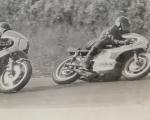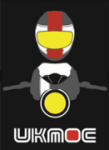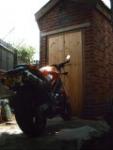Quote:
Originally Posted by 350TSS

Re the above I am still troubled by the TF diagram. I am not an engineer nor am I a mathematician (O level just 51 years ago).
What caused me to be troubled was the news that Marc Marquez has been recorded as taking a corner with a record 66 degrees of lean and I wondered what the cornering force could be, so I thought I would try to calculate it. Would the force be higher or lower once 45 degrees of lean was passed?
As I thought about it further I was also worried by the statement that the diagram only worked for 45 degrees. One should be able to calculate at 5 degree increments and plot a graph.
To help me consider the issue I drew a quarter of a circle and plotted 10 degree increments including one last position at 66 degrees. It is a frighteningly long way over.
I also thought about the effect the rider would have by shifting weight off and inboard of the machine as the corner is taken. I think a MotoGP bike has a mass of about 135 kg and Marc fully kitted probably weighs about 65 kgs so all up about 200 kgs.
Looking at the TF diagram in the vertical position the force is through the rider to the tyre contact patch and is the Wt in kgs. I could not work out the position anywhere between the tyre contact patch and the top of the rider’s head which is the correct position to measure from. I concluded that it could only theoretically be measured from the centre of gravity of the rider/ bike combination and for the purpose of simplification of the calculation one would have to assume that the rider remained in the same place on the seat.
Also for the sake of simplicity and my other severely overloaded brain cell I have assumed that the centre of gravity of the Marc and bike combination is 750mm above the tyre contact patch in the vertical position. As the bike leans the CofG of the bike /rider combination prescribes an arc 750mm distant from the tyre contact patch with increasing lean angle reducing the height of the C of G above the ground level.
Mr Foale’s diagram has the radius of this arc as the hypotenuse of a right angle triangle and in his case the answer is always the square root of 2 x the weight in kgs. Force is not measured in kgs but rather in Newtons.
I am obviously missing something
Discuss?
|
The neat thing about vectors is that they have length and direction.
The root two only applies to 45 degree triangles. In this case the angles are different.
For Mr Marquez, if you draw a triangle with horizontal base line, a vertical side and a diagonal line at 66 degrees from vertical.
The vertical line shall represent the weight of bike and Marc, say 200 Kg force. The horizontal line represents the turning force and the diagonal the force in the suspension.
For this 66 degree rightangled triangle, the hypotenuse is 2.459 times longer than the vertical short side, so Marc is pulling 2.459 G around that corner, plus any acceleration or braking.
The suspension thinks that he and the bike now weigh 491.7Kg.












 (45° = 1g)
(45° = 1g)




 Linear Mode
Linear Mode

